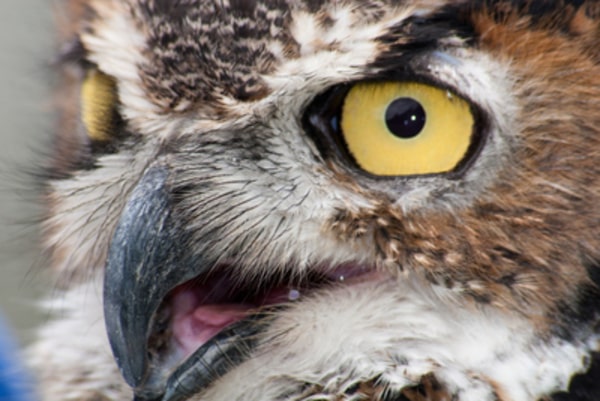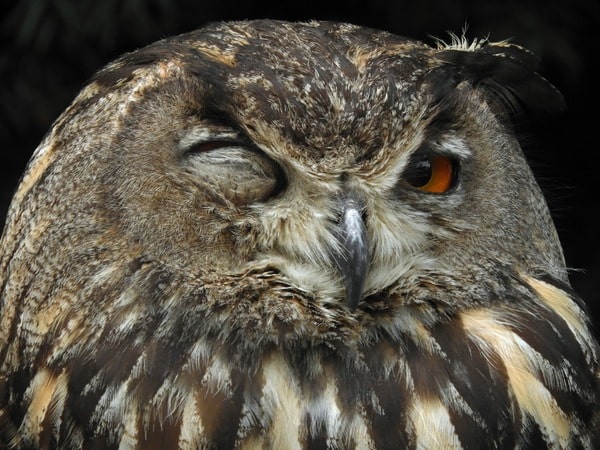Owls do blink-but not in the way humans expect. Their eyes are so specialized for hunting that evolution gave them three eyelids, each with a different job. The upper eyelid blinks, the lower eyelid closes during sleep, and a third eyelid the nictitating membrane moves sideways across the eye to keep it clean and protected while the owl continues seeing. This membrane does most of the “blinking work,” which is why owls often look like they never blink at all. Their system keeps the eyes hydrated, shields them during hunting, and maintains clear vision without interrupting focus.
When Owls Actually Do Blink And What Each Type of Blink Means
Owls don’t blink often, but when they do, every blink serves a purpose. Their eyes aren’t like ours they’re long, tube-shaped, locked in place, and constantly exposed to dust, wind, feathers, and whatever their prey kicks up. So instead of blinking casually like humans, owls use each type of blink with intention. Their eyelids act more like specialized tools than simple shutters.
1. The True Blink: Upper Eyelid Moving Downward
If you ever catch an owl giving a slow, deliberate blink, you’re seeing something rare. Most birds raise their lower eyelid to blink, but owls stand out they blink with the upper eyelid, just like we do. It’s one of the few moments where their expression softens and feels strangely human.
Owls use this true blink when:
- Their eyes need a quick wash of moisture
- They’re feeling calm, relaxed, or grooming
- The lighting suddenly shifts
- Something touches or irritates the eye
Because vision is everything to a hunting owl, they avoid blinking in the middle of high alert. This blink is slower, more controlled, and much less frequent than the rapid blinking we’re used to.
2. The Nictitating Membrane Sweep: The Blink You Rarely See
This is the owl’s real blink the one happening constantly in the background.
The nictitating membrane is a thin, pale, almost transparent film that sweeps sideways from the inside corner of the eye. It works so smoothly and quietly that most people don’t notice it at all.
This membrane acts like a built-in safety and cleaning system:
- Wipes the eye clean like a windshield wiper
- Keeps the surface hydrated without breaking visual focus
- Shields the eye during flight and prey strikes
- Blocks dust, feathers, wind, and debris
- Maintains partial vision even while protecting the eye
When you see an owl staring intensely without blinking, that’s only half true. It is blinking just with a membrane you barely notice. This is how owls keep their eyes safe while still following every movement around them.
3. The Sleep Blink: Lower Eyelid Closing Upward
When an owl finally decides it’s safe to rest, another eyelid takes over the lower eyelid, which rises upward to close the eye completely. This is their dedicated sleep shutter, built to stay closed for long periods without drying out.
Owls use this eyelid when:
- They enter deep, restorative sleep
- They roost during the day (for nocturnal species)
- They need to protect moisture during long rest cycles
Even with both outer eyelids closed, the nictitating membrane may keep moving underneath, maintaining eye health throughout the night. Most owls sleep 8–12 hours, depending on species and daylight patterns, and the sleep blink is what keeps their powerful eyes safe during that downtime.


Do Owls Close Their Eyes at All? What Studies Reveal About Sleep Blinking
Owls absolutely close their eyes, but they do it in a way that feels almost opposite to how most birds do it. Instead of lowering the upper eyelid like we do or raising the lower eyelid like many other birds owls rely on a strong, upward-moving lower eyelid to fully shut their eyes when they rest. Field studies of roosting owls consistently show this upward closure, creating a tight seal designed to protect their eyes during long periods of sleep.
This lower eyelid is thicker and sturdier than the upper one because it’s built for long-term use. When an owl sleeps for hours often 8 to 12 hours, depending on species this eyelid keeps its eyes safe from drying, dust, and harsh daylight.
Researchers observing resting owls have also noted several behaviors linked to eye closure:
- They sometimes close their eyes only halfway when they’re relaxed, grooming, or enjoying a warm patch of sunlight.
- The nictitating membrane may continue moving beneath the eyelids, quietly keeping the eye moist even when the outer lids are shut.
- Owls often look “half-asleep” because the lower eyelid rises slowly, and partial closure still allows them to stay aware of movement.
- Young owls show more visible blinking because their nictitating membrane is still developing its strength and speed.
Owls rarely shut their eyes fully unless they feel completely safe. An owl that’s alert even if it looks still will keep its eyes open and rely on its nictitating membrane to handle moisture and protection without losing sight of what’s happening around it. Closing the eyes fully means letting go of vigilance, and for a predator that depends on vision for survival, that’s a big decision.
Blinking of screech owl Video

